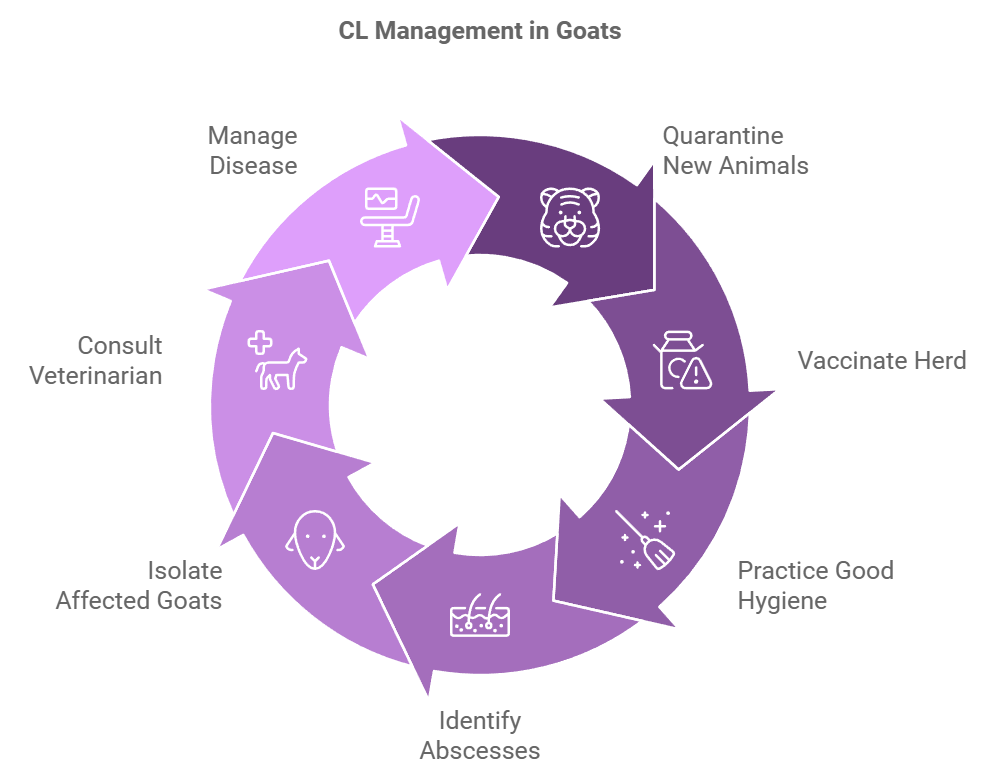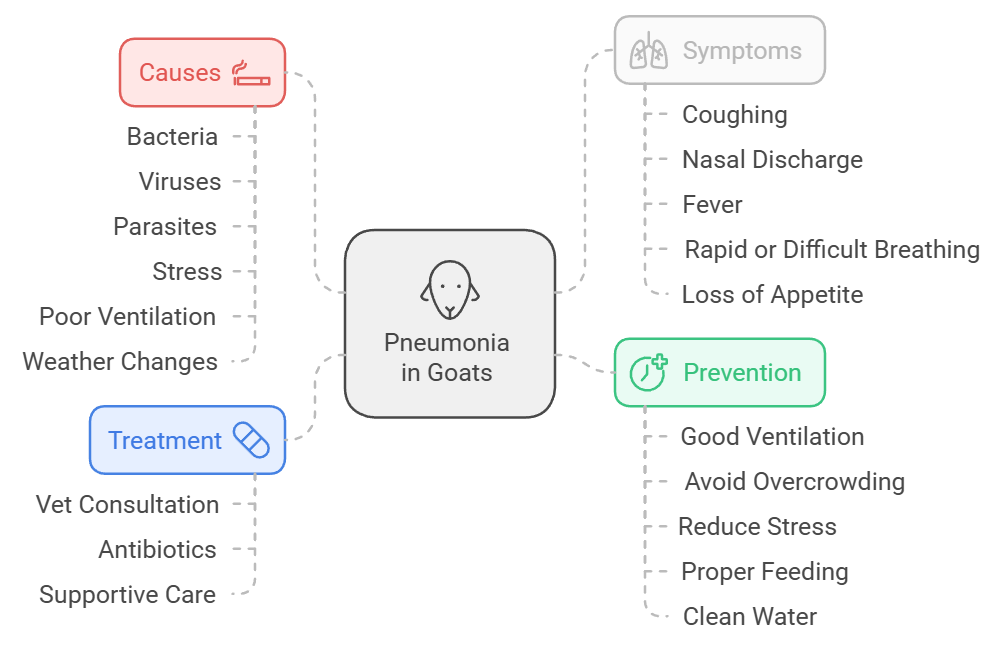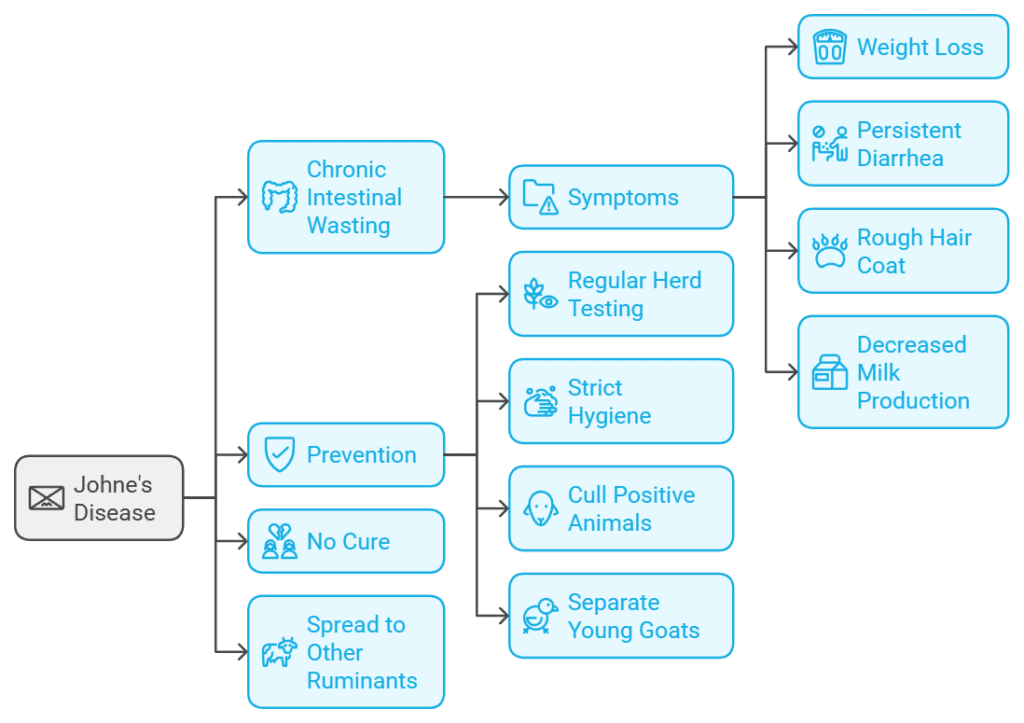Did you know that a single diseased goat can put your entire herd at risk? I sure didn’t when I first started out, did I learn that lesson the hard way.
Listen, I’ve been in the goat game for over one decades now, and if there’s one thing I’ve learned, it’s that knowing your common goat diseases is as crucial as knowing which end of the goat to milk.
These little capricious creatures might seem tough, but trust me, they can go from frisky to flat-out sick faster than you can say “Billy goat gruff.” And when that happens, it’s not just your goat’s health on the line – it’s your farm’s productivity and your wallet that take a hit too.
So, grab a cup of coffee (or goat’s milk if you’re feeling fancy), and let’s look the top 10 goat diseases every farmer should know. I promise you, by the end of this article, you’ll be better equipped to keep your herd healthy, happy, and productive. And who knows? You might even save yourself a few grey hairs in the process!
Goat Diseases: Caprine Arthritis Encephalitis (CAE)

CAE – the silent troublemaker of the goat world. I remember the first time I encountered this disease in my herd. It was like watching a slow-motion train wreck, and let me tell you, it wasn’t pretty.
CAE is caused by a little virus that spreads mainly through milk and colostrum. It’s like the ninja of goat diseases – by the time you notice something’s wrong, it’s already made itself at home in your herd.
What to watch for? Well, if you see your goats walking like they’ve had one too many at the fermented grain bar, with swollen joints and a general “I feel lousy” attitude, CAE might be the culprit. In severe cases, you might even see neurological symptoms – yeah, it can affect their brains too. Talk about a headache!
Now, prevention is where it’s at with CAE. There’s no cure, so once a goat has it, they’ve got it for life:
- Test, test, test! Get your herd tested regularly.
- If you’ve got CAE-positive goats, keep them separate from the negative ones.
- For newborn kids, snatch ’em away from CAE-positive moms before they can suckle and feed them heat-treated colostrum and pasteurized milk.
Treatment? Well, it’s more about management than cure. Keep your CAE-positive goats comfortable, treat those swollen joints, and be prepared to make some tough decisions if the Goat dseases progresses.
Remember,- with CAE, an ounce of prevention is worth a pound of cure. Actually, scratch that. It’s worth a whole truckload of cure!
Caseous Lymphadenitis (CL) : ( Goat Diseases )

Alright, let’s talk about CL – or as I like to call it, “the lumpy bumpy disease.” This bacterial baddie is caused by Corynebacterium pseudotuberculosis. Try saying that five times fast after a long day of goat wrangling!
CL is like that unsightly pimple that always pops up before a big date – except it’s on your goat, and it’s filled with nasty, infectious pus. Gross, I know, but we’re all farmers here, right?
You’ll typically see CL manifest as abscesses, usually around the head, neck, and shoulders. But don’t be fooled – it can also set up shop internally, where you can’t see it. Sneaky little devil.
Prevention is key:
- Quarantine new animals before introducing them to your herd. Trust me, a few weeks of separation beats years of battling CL.
- Vaccinate your herd. It’s not 100% effective, but it can reduce the severity and spread of CL.
- Practice good hygiene. Clean and disinfect equipment regularly, especially anything that might break the skin.
If you do spot an abscess, don’t pop it! I know it’s tempting, but trust me, you’ll just spread the infection. Instead, isolate the affected goat and call your vet. They can lance and drain the abscess safely.
Treatment is tricky with CL johnes disease. Antibiotics aren’t very effective, so it’s mostly about managing the disease. Some Farmar’s choose to cull affected animals to protect the rest of the herd. It’s a tough decision, but sometimes it’s necessary.
Remember, CL can spread to humans (yeah, you read that right), so always wear gloves when handling affected goats or abscesses. Your hands will thank you!
Sirohi Goat Farming: Tips for Success and Sustainable Practices
Black Bengal Goat Farming: A Simple Guide for Indian Farmers
Pneumonia : ( Goat Diseases )

Pneumonia – it’s not just for people! Our caprine companions can catch this nasty respiratory disease too, and let me tell you, it’s no walk in the pasture.
I’ll never forget the time I walked into my barn on a chilly autumn morning and heard what sounded like a goat coughing convention. Yep, pneumonia had come to visit, and it wasn’t bringing any house-warming gifts.
Pneumonia in goats can be caused by various culprits – bacteria, viruses, even parasites. But often, it’s a perfect storm of stress, poor ventilation, and sudden weather changes that sets the stage for these baddies to take hold.
So, what should you be on the lookout for?
- Coughing (obviously)
- Nasal discharge (snot city!)
- Fever
- Rapid or difficult breathing
- Loss of appetite (when a goat turns down food, you know something’s up)
Preventing pneumonia is all about management.:
- Ensure your barn has good ventilation. Goats don’t like drafts, but they need fresh air!
- Don’t overcrowd your goats. They need their personal space, just like your Aunt Mildred at family reunions.
- Reduce stress. Yes, goats can get stressed too. No loud rock music in the barn!
- Keep your goats well-fed and provide plenty of clean water.
If pneumonia does strike, don’t panic! Call your vet pronto. They’ll likely prescribe antibiotics for bacterial pneumonia. You might also need to provide supportive care – think warm, dry housing and plenty of TLC.
Remember, pneumonia can be particularly hard on young kids and older goats. So keep an extra close eye on the young’uns and the grandmas of your herd.
And here’s a pro tip: learn to use a stethoscope. Being able to listen to your goat’s lungs can help you catch pneumonia early. Plus, it makes you feel like a real doctor. Dr. Goat, at your service!
Foot Rot : ( Goat Diseases )
Ah, foot rot. The bane of every goat farmer’s existence. It’s like athlete’s foot, but for goats, and about a hundred times worse. Trust me, I’ve dealt with my fair share of stinky, limping goats over the years.
Foot rot is caused by a dynamic duo of bacteria that throw a party in your goat’s hooves when conditions are just right (or should I say, just wrong). We’re talking warm, moist environments – like that muddy patch near the water trough that you’ve been meaning to fix for months. (No judgment here, we’ve all been there!)
Early signs of foot rot include:
- Limping (like your goat just came from a wild barn dance)
- Red, swollen skin between the toes
- Foul odor (imagine a mix of rotten eggs and old cheese – yum!)
If left untreated, the infection can cause the hoof to separate from the foot. Yeah, it’s as nasty as it sounds.
Prevention is your best friend when it comes to foot rot. Here’s what can you do:
- Keep your goat areas as dry as possible. Drainage, drainage, drainage!
- Trim hooves regularly. It’s like a pedicure, but less relaxing and more… goat-y.
- Use a foot bath with zinc sulfate or copper sulfate solution. It’s like a spa day for your goats’ feet!
- Quarantine new animals and check their feet before introducing them to the herd.
If foot rot does rear its ugly head, don’t despair. Treatment usually involves trimming away the infected hoof tissue (wear a mask – trust me on this one), applying topical treatments, and possibly giving antibiotics in severe cases.
And here’s a little secret: some goats seem more resistant to foot rot than others. If you’re breeding your own herd, keep an eye out for these tough-footed individuals. They might just be your ticket to a foot rot-free future!
Remember, happy feet make for happy goats. And happy goats make for a happy farmer. So keep those tootsies in tip-top shape!
Mastitis ( Goat Diseases )
Let’s talk about mastitis, shall we? It’s the udder enemy of dairy goat farmers everywhere. (See what I did there? Udder? I’ll show myself out…)
Mastitis is an inflammation of the mammary gland that can turn your goat’s milk production into a painful nightmare. I’ve seen it turn even the sweetest doe into a kicking, stomping milk machine of fury.
Mastitis can be caused by various bacteria, but often it’s the result of poor milking hygiene or udder injuries. It can be acute (sudden and severe) or chronic (long-lasting and subtle).
Signs to watch for include:
- Hot, swollen, or painful udders
- Changes in milk consistency (chunks, watery milk, or blood in the milk)
- Reduced milk production
- Fever and loss of appetite in severe cases
Preventing mastitis is all about good management:
- Practice excellent milking hygiene. Clean udders, clean hands, clean equipment. Did I mention clean?
- Milk completely at each milking. Don’t leave milk in the udder – it’s like an all-you-can-eat buffet for bacteria.
- Maintain a clean, dry environment for your goats. Muddy, manure-filled areas are mastitis breeding grounds.
- Consider teat dipping after milking to close the teat orifice and prevent bacteria from entering.
If mastitis does strike, act fast! Mild cases can often be treated with frequent milking and warm compresses. More severe cases may require antibiotics – always consult your vet for the best course of action.
And here’s a tip from the trenches: invest in a good California Mastitis Test kit. It’s like a home pregnancy test, but for mastitis. It can help you catch subclinical cases before they become full-blown problems.
Remember, healthy udders are the key to happy dairy goats and high-quality milk. So keep those mammaries in tip-top shape, and your goats will thank you!
Enterotoxemia (Overeating Goat Diseases)
Enterotoxemia, or “overeating disease,” is proof that too much of a good thing can indeed be bad – even for goats! It’s like that time I ate an entire cheesecake in one sitting. Except for goats, the consequences are a lot more severe than a stomachache and regret.
This disease is caused by Clostridium perfringens bacteria, which are normally present in the goat’s gut. But when a goat overindulges in grain or lush pasture, these bacteria can multiply rapidly and produce toxins. It’s like a microbial frat party in your goat’s gut, and trust me, the aftermath isn’t pretty.
Enterotoxemia can affect goats of all ages, but it’s particularly nasty for kids. Symptoms can include:
- Sudden death (yeah, it can be that fast)
- Severe diarrhea
- Abdominal pain
- Depression and loss of appetite
- Neurological signs like star-gazing or convulsions
Prevention is crucial because once symptoms appear, it’s often too late. Here’s what can You do:
- Vaccinate! It’s your best defense. Follow a proper vaccination schedule for kids and adults.
- Introduce diet changes gradually. No sudden all-you-can-eat grain buffets!
- Provide plenty of roughage. It’s like fiber for goats – keeps things moving along.
- Don’t overfeed grain, especially to young kids.
If you suspect enterotoxemia, call your vet immediately. Treatment can include administering antitoxin, antibiotics, and supportive care, but it’s often a race against time.
Tip: keep some activated charcoal on hand. If you catch the disease early, administering activated charcoal (under vet guidance, of course) can help absorb toxins in the gut.
Remember, when it comes to feeding your goats, slow and steady wins the race. Your goats might give you the sad eyes when you limit their grain, but trust me, they’ll thank you for it in the long run!
Johne’s Disease : ( Goat Diseases )

Johne’s disease – it’s like the stealth bomber of the goat disease world. By the time you see it, it’s already done a whole lot of damage.
Caused by a bacteria with a name that sounds like a sneeze (Mycobacterium avium subspecies paratuberculosis, if you’re curious), Johne’s disease is a chronic wasting condition that primarily affects the intestines.
The tricky thing about Johne’s is that goats can be infected for years before showing any symptoms. It’s like having a secret agent in your herd, slowly sabotaging from within.
When symptoms do appear, they can include:
- Gradual weight loss despite a good appetite (the goat equivalent of every human’s dream, except it’s not healthy)
- Diarrhea that comes and goes, then becomes persistent
- Rough hair coat
- Decreased milk production
Preventing Johne’s is all about biosecurity and management:
- Test your herd regularly. Knowledge is power!
- Practice strict hygiene, especially around kidding areas.
- Cull positive animals. It’s tough, but necessary to protect your herd.
- Raise kids separately from adults, and feed them milk from Johne’s-negative does.
There’s no cure for Johne’s, so treatment is really about managing the infected animals and preventing spread. It’s a tough disease to deal with, both emotionally and economically.
Here’s a sobering thought: Johne’s can spread to other ruminants, including cattle and sheep. So if you’ve got a mixed farm, you need to be extra vigilant.
Remember, with Johne’s, an ounce of prevention is worth a ton of cure. Actually, there is no cure, so make that a million tons of prevention!
Parasitic Infections : ( Goat Diseases )
Ah, parasites. The uninvited guests at the goat party. These little freeloaders can cause big problems if left unchecked.
In my early days of goat farming, I made the mistake of thinking my goats looked fine, so they must be fine. Boy, was I wrong! A fecal test revealed more parasites than you could shake a stick at. Lesson learned: what you can’t see can hurt your goats!
Common parasites in goats include:
- Barber pole worms (the vampires of the parasite world)
- Coccidia (particularly nasty for kids)
- Liver flukes (they’re as delightful as they sound)
- External parasites like lice and mites (itchy!)
Signs of parasite infestation can include:
- Weight loss or poor growth
- Rough, dull coat
- Diarrhea
- Anemia (check those eyelids!)
- Bottle jaw (swelling under the jaw)
Preventing parasites is an ongoing battle. Here’s my strategy:
- Practice rotational grazing. Don’t let your goats graze an area down to bare dirt.
- Keep your goat areas clean and dry. Parasites love moisture!
- Use FAMACHA scoring to check for anemia in your goats.
- Perform regular fecal tests to monitor parasite loads.
When it comes to treatment, the old “deworm everything on a schedule” approach is outdated. Nowadays, it’s all about selective deworming to prevent resistance. Work with your vet to develop a parasite management plan tailored to your herd and region.
Some herbs like wormwood and garlic are natural dewormers. While they shouldn’t replace conventional dewormers entirely, they can be a helpful addition to your parasite-fighting toolkit.
Remember, a parasite-free goat is a happy goat. And happy goats make for a happy farmer!




